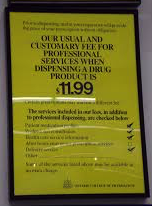Pharmacy “Dispensing” Fees
Equal Pay for Equal Work

Most people know that pharmacies charge a professional fee, or “dispensing” fee, for each prescription. However, you may not know why.
The Old Way
In many parts of the world, medications are sold like other goods. The drugstore buys them, marks them up like any other product, and sells them to the customer. Often, a pharmacist is not even there to teach them how to use the medication safely and correctly. Markups of 50% or more are not uncommon, since most retail business have overhead costs of at least 15 – 20% before profits. Overhead costs (labour for pharmacists and staff, rent, taxes, borrowing costs, heat, hydro, technology, telephones, advertising, delivery costs, etc.) can be even higher in developed countries like Canada, especially in major cities, and particularly where highly-paid professional staff are employed.
The Current Way
Just a few decades ago, Canada also used this retail approach. However, as more drugs were invented, prescribed, and used, drug costs started to rise. Drug manufacturers started selling only through wholesalers, which increased costs to pharmacies, who passed them along to payers. The biggest payers are provincial governments, and in an effort to control costs, they devised a new method: pharmacies would no longer be eligible for retail markups, but they could charge a fee to cover their overhead costs. A portion of this new fee would also have to cover the return on the investment (ROI) for the risk the pharmacy owner took in the business (after 7 years of expensive university training).
They did the right thing. These governments knew that, with the advent of biotechnology on the horizon, prescription drugs would become ever more expensive. Most pharmacies today would be more than happy to trade their dispensing fees for a 50+% markup on today’s expensive drugs.
The Ontario Drug Benefit (ODB) program pays for prescription medicines for seniors and low income individuals. Drug wholesalers charge pharmacies almost 6% on top of the manufacturer’s list price for the drug. To offset this cost, ODB pays a 6% markup to the pharmacy. i.e. 6 – 6 = 0 markup. Inexpensive drugs do get a couple of percent more, but there are lots of products that get no markup (nutritional products like Ensure™ and Boost™), and even more where ODB pays less than acquisition cost. It’s a mess. Most insurance plans pay a more reasonable 10%, but this still falls way short of typical overhead costs. The dispensing fee is supposed to provide for the real ROI.
“Dispensing” Fees
How does a pharmacy calculate their prescription fee? The pharmacy projects its annual costs of providing services (or COPS), adds their expected Return on Investment (ROI), and divides this by the annual number of prescriptions. i.e.
FEE = (COPS + ROI) divided by Number of Expected Prescriptions
This means that the pharmacy’s prescription costs are spread out equally over time, and over all of the prescriptions that they receive. This makes for a low, predictable service fee for all clients.
Furthermore, the same work goes into every prescription, and it’s a lot more than simple “dispensing” (which is why pharmacists dislike the term “dispensing fee”). Most people don’t know everything that their pharmacist does when responding to a prescription request. Pharmacists:
- Make sure the prescription is written legally
- Evaluates it to ensure it is safe and effective for every individual patient
- For their unique medical conditions
- Allergies
- Other medications
- Genetic factors
This is just to name a few of the regularly done tasks done for every prescription, not just expensive ones. Equal pay for equal work.
Ever pick up the phone, or just drop into the pharmacy, and ask the pharmacist a question? Did you need an appointment? How long did you have to wait? Ever go to the pharmacy looking for an over the counter (OTC) medicine, and have the pharmacist tell you that you didn’t need the medicine, and that non-medication approaches would be better? (btw, we do this all the time). They didn’t sell you anything. Did they charge you for their time? Do you know any other health professional that gives such important advice, every single day, for free? It’s not free. These costs are covered by the prescription fees.
Yes, it’s an informal system. Yes, it is a bit unclear. But would anyone prefer that their pharmacist charge them billable time by the minute, the way that legal professionals do? Somehow I doubt it.
Sometimes the fee is more than the cost of the medication, which also doesn’t seem to make sense. Some drugs cost just a fraction of a cent per tablet. However, if not prescribed or used correctly, these inexpensive drugs can kill a person just as easily as expensive ones. There is a reason their supply is carefully controlled. Pharmacists catch, and fix, scores of drug-related problems and prescribing errors every single day. We do not pay any less attention to the inexpensive drugs. Pharmacists are the last line of defence between the public and potentially deadly effects of medications.
In 2006, the average cost of dispensing in Ontario, before ROI, was estimated at around $14.00. Add ROI, and the average fee would be higher. However, most pharmacies charge a lower fee due to competitive pressures. They have to find ROI in front store sales, volume purchasing discounts, etc. just in order to keep the business running.
In the past, some major pharmacy retailers have intentionally lost money on prescriptions by advertising bargain basement fees to attract new business, especially when they first open. This is called a “loss leader”. This sends the message that the fee is the most important consideration when choosing a pharmacy provider for your family, and not your actual health care.
Most insurance plans allow a prescription fee, but it is also usually less than the average COPS. Some insurance companies use the fee as leverage against the patient, paying only a portion of the fee, or none at all, and sometimes encouraging patients to leave their family pharmacist for one charging lower fees. This also sends the message that the fee should be the focus, instead of the quality of the health care provided.
The Ontario Drug Benefit (ODB) program pays a prescription fee of $8.83. In theory. This payment to the pharmacy is reduced by $2 (to $6.83) for low income individuals, and lowered even more for so-called “high-income” seniors: a whopping $6.11 reduction, down to a fee of $2.72. Notwithstanding the fact that these don’t even come close to covering the cost of dispensing, the pharmacist is then expected to be the government’s tax collector, demanding these user fees from customers. No other publicly funded health professional is asked to do this. User fees are supposed to discourage unnecessary use of drugs. However, the collection of these user fees is not even mandatory. How important can they be? One is left to conclude that it is merely an excuse to grab money out of pharmacy payments, and to destabilize the pharmacy profession.
User Fees
This is one of the reasons why pharmacists hate user fees (aka copays), especially for low income individuals and families. The other reason is that the RAND Health Insurance Experiment (Click to View) showed that low income individuals are more likely to forego needed health services because of user fees. These should be eliminated. People should be able to choose their pharmacist based solely on how well they look after their family’s health, just like every other health professional. Period.
What You Should Ask
Nothing is more frustrating than receiving a phone call from a new potential client, and hearing the first words they ask: “What is your dispensing fee?” A better alternative might be: “Can you help me better control my diabetes?” (we can), or “Do your pharmacists have any specialized training certifications?” (we do), or “Do you provide community education sessions on health topics?” (frequently).
COVID-19
During the recent COVID-19 crisis, pharmacists have been publicly thanked by many people, including the Prime Minister himself, for our willingness to keep serving the public in these dangerous conditions. However, we are just doing the essential, irreplaceable work we have always done.
Finally, pharmacists have also had to be the messengers of the provincial initiative that limits prescription quantities to a maximum of 30 days to prevent stockpiling during COVID. This will help to ensure equal access to lifesaving medicines. Because most people are decent human beings, they understand the wisdom behind this. However, as mentioned above, the same work goes into every prescription, every time. It is only fair and consistent that the same fee is charged. Equal pay for equal work. For people to call this “price gouging” just shows how little they understand how pharmacies work. Then again, most people don’t work in pharmacies, so how would they know? Perhaps the above might help them better understand. God Bless, and Keep Safe.
Faisal Khawaja, RPh

